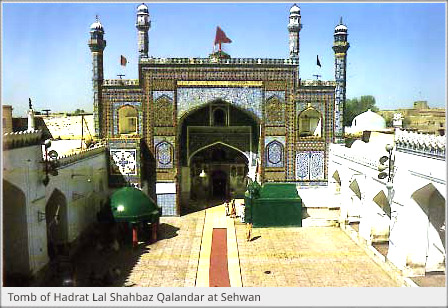 Though Muslims entered South Asia with the conquest of Sindh by Muhammad bin Qasim and then with the annexation of Punjab by Mahmud Ghaznavi, yet the real credit of the establishment of Muslim rule in the region goes to Shahab-ud-din Muhammad Ghuri. The Ghurids had a long history of differences with the Ghaznavids, which ultimately resulted in the capture of Ghazni at the hands of Ghiyas-ud-din Muhammad bin Sam, the ruler of Ghur, in 1173. Ghiyas-ud-din handed over Ghazni to his younger brother Muhammad Ghuri and himself concentrated on the conquest of Khorasan. After taking charge of Ghazni, Muhammad Ghuri spent most of his time in preparation for an attack on South Asia. In 1175, he invaded the Sub-continent for the first time through the Gomal pass and occupied Multan and Uch, but failed to capture Gujrat. He again came through the Khyber Pass with the aim of attacking the Ghaznavid territories. He managed to capture Peshawar in 1179 and Sialkot in 1185. After defeating the last Ghaznavid ruler, Khusau Malik, he occupied Lahore in 1186.
Though Muslims entered South Asia with the conquest of Sindh by Muhammad bin Qasim and then with the annexation of Punjab by Mahmud Ghaznavi, yet the real credit of the establishment of Muslim rule in the region goes to Shahab-ud-din Muhammad Ghuri. The Ghurids had a long history of differences with the Ghaznavids, which ultimately resulted in the capture of Ghazni at the hands of Ghiyas-ud-din Muhammad bin Sam, the ruler of Ghur, in 1173. Ghiyas-ud-din handed over Ghazni to his younger brother Muhammad Ghuri and himself concentrated on the conquest of Khorasan. After taking charge of Ghazni, Muhammad Ghuri spent most of his time in preparation for an attack on South Asia. In 1175, he invaded the Sub-continent for the first time through the Gomal pass and occupied Multan and Uch, but failed to capture Gujrat. He again came through the Khyber Pass with the aim of attacking the Ghaznavid territories. He managed to capture Peshawar in 1179 and Sialkot in 1185. After defeating the last Ghaznavid ruler, Khusau Malik, he occupied Lahore in 1186.
After taking over the Ghaznavid area of Punjab, Ghuri decided to fight against the Hindu Rajputs. In 1191 he conquered Bhatinda in the territory of Chauhans and then decided to go back to Ghazni. On his way back he was told that Prithvi Raj had started marching towards Bhatinda in order to recapture the fort. Ghuri had to return to defend his conquest. The two forces met at Tarain and a bloody war was fought. Ghuri fainted during the war and Rajputs reclaimed Bhatinda. Back in Ghazni, Ghuri spend a year in preparation and then attacked the Rajputs again. The result of the second battle of Tarain, fought in 1192, was totally opposite from the first one. The Rajputs were defeated and Prithvi Raj was killed. Victory in the second battle of Tarain opened the door to further conquests for Ghuri. Muslims defeated many of the Rajput clans and captured Badaun and Oudh. Kanauj and Benares were captured in 1194, and Bayana and Gawalior in 1195. One of Ghuri’s most trusted lieutenants, Qutb-ud-din Aibak moved forward and captured Delhi in 1196. Ghuri himself went back to Ghazni but appointed Aibak as his viceroy in the region and was keen to receive feedback on the political and social activities of Delhi. Aibak was the first Muslim Governor of Delhi.
Ghuri appointed another of his slaves, Muhammad bin Bakhtiyar Khilji, to look after the land of Oudh. With the revenue coming from the land, Khilji established a small force of horsemen. With the support of these horsemen, Khilji captured Bengal and some parts of Assam. Ghuri appointed Khilji as the governor of Bengal.
Unlike Mahmud Ghaznavi, Ghuri showed more interest in South Asia and established his permanent hold in the region. After his death, his Turkish slaves ruled the region and left a great impact on history. The Muslim rule established by Muhammad Ghuri in South Asia lasted for more than seven centuries.
This article was last updated on Sunday, June 01, 2003



